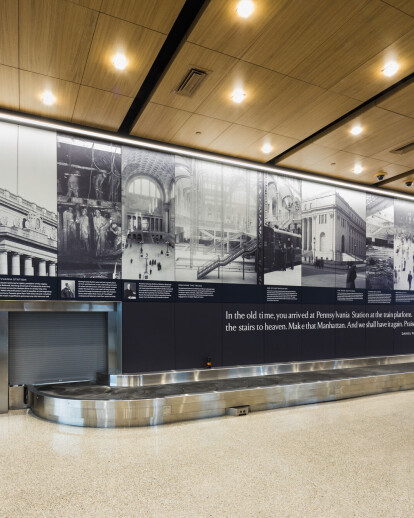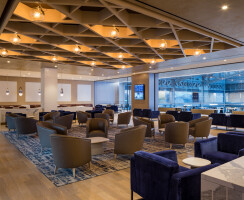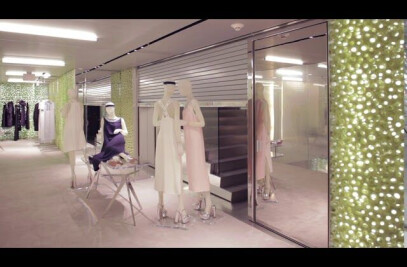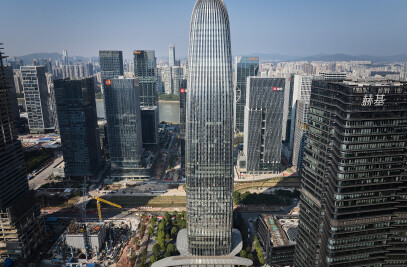MOYNIHAN TRAIN HALL, MONUMENTAL CIVIC PROJECT THAT RESTORES GRANDEUR OF TRAIN TRAVEL IN NEW YORK
Designed by SOM, the Moynihan Train Hall completely reimagines the travel experience at the busiest transportation hub in the Western Hemisphere, and evokes the architectural heritage of New York’s original Pennsylvania Station.
Governor Andrew M. Cuomo and Skidmore, Owings & Merrill are celebrating the completion of a long-held New York dream. The new Daniel Patrick Moynihan Train Hall, named for the visionary United States senator who proposed the project in the 1990s, will open its doors on January 1 to New Yorkers and travelers from the Long Island Rail Road, Amtrak, the New York City Subway, and the entire northeast region. It is one of the most monumental civic projects undertaken in the city in a generation, and transforms the way millions of people interact with one of the world’s largest cities.
Moynihan Train Hall expands the Pennsylvania Station complex with a 255,000-square-foot rail hub in the landmark James A. Farley Post Office Building. Situated across Penn Station between Eighth and Ninth Avenues and West 31st and 33rd Streets, it reverses the dark, overcrowded experience that so many commuters have endured for decades. It brings light to the concourses for the first time in more than 50 years, increases total concourse space by 50 percent, and restores the grandeur that was lost with the demolition of the original Penn Station half a century ago.
“This is an incredibly important moment in the history of New York City,” said SOM Partner Colin Koop. “We’ve designed a place that evokes the majesty of the original Penn Station, all while serving as a practical solution to the issues that commuters in, to and from New York have endured for too long. By connecting to our architectural past through the adaptive reuse of the Farley Post office building, we are breathing new life into New York, and recreating an experience no one has had here in decades.”
Laura Ettelman, SOM Managing Partner, continues, “SOM has been working on this project since 1998 – for more than two decades. Our deep commitment to this project has been fueled by the profound belief that New York City is better because of projects like this.”
That original Pennsylvania Station was designed by McKim, Mead & White in 1910. It was a skylit, Beaux-Arts masterpiece that celebrated travelers’ arrival to New York City. After its demolition in 1965, only its concourses and platforms remained, and they were all underground in a space downgraded to accommodate only 200,000 people. Five decades later, the number of people passing through the station every day swelled to more than 600,000, while the Farley Building – also designed by McKim, Mead & White in 1913, with a grand staircase and colonnade that echoed the firm’s design for Penn Station – had become 95 percent vacant. Residing above Penn Station’s tracks, the Farley Building was the perfect place for a new train station.
“One of the most remarkable things about this project is the way that it transforms an under-utilized and underappreciated building into a new, inviting front door for this city,” said Roger Duffy, the retired SOM Design Partner who led the project for the firm. “The train hall is at the core of this transformation. It is designed with lightness and warmth, which combine to reestablish the essence of what it means to come to New York.”
The new train hall, located in the former mail sorting room, is designed with a dramatic skylight that traverses the entire space – much like the original Penn Station did in 1910. The skylight, designed with the structural engineering firm Schlaich Bergermann Partner, is arranged in four catenary vaults. To support the structure, SOM uncovered the building’s three massive steel trusses, which had been invisible to the postal workers a century ago, and chose to reveal them as a major focal point of the design. With a web-like structure, the bolted trusses add an extra sense of lightness to the train hall – establishing a modern look and feel while displaying the workmanship of neoclassical design.
Each of the four catenary vaults is composed of more than 500 glass and steel panels that come together to form a moiré effect. At the edges of each vault, the panels thicken to sustain greater structural loads, while at the apexes, which span 92 feet above the concourse, the panels’ depth lightens to enhance the airy ambience of the space. The trusses are each equipped with new lighting fixtures that illuminate the train hall at night. On the middle truss, a new clock – designed by Pennoyer Architects and inspired by the analog clocks that were once prevalent at the original Penn Station – marks the center of the room.
Along the eastern wall, four large LED screens feature New York State imagery designed by Moment Factory, and help brighten the train hall at night. Hospitality spaces – including ticketing kiosks and information kiosks designed by SOM, Amtrak waiting rooms on the concourse level designed by Rockwell Group, an Amtrak Metropolitan Lounge by FX Collaborative, and a food hall designed by Elkus Manfredi – surround the space on two floors to establish an inviting experience that provides all the amenities a commuter will need. The signage and wayfinding identify the hospitality and platform entries by color to enable intuitive circulation through the station – an element that has largely been missing in the confusing corridors of Penn Station for the last 50 years.
The interior spaces of the station, including the train hall, share a unified material aesthetic. Drawing inspiration from the existing, historic post office at the top of the Farley Building’s staircase as well as Grand Central Terminal, SOM designed the station’s interiors with Tennessee Quaker marble, a material that evokes that sense of warmth, calmness, and grandeur that are central to the design.






































